
West Salem's Veterans' Memorial Park
(written by Anita Taylor Doering, Archives Staff)
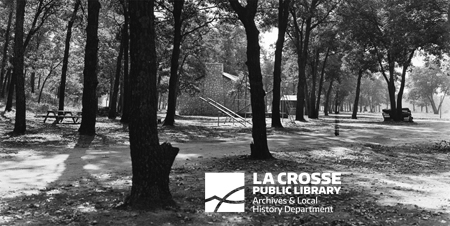
Photograph thought to have taken by Sander Johnson, courtesy of Reeta Berg
Originally called Waterloo Park, Veterans’ Memorial Park was one of three original parks set aside In La Crosse County shortly after the State of Wisconsin established the county park system in 1907. Waterloo Park was initially north of where it sits now, off Gills Coulee Road. In the beginning, the land for Waterloo Park was shared on the weekdays with the owning farmer's cattle. This meant that the park was enclosed behind a barbed wire fence and to access it, park visitors had to climb over the barbed wire fence using a stile. How pleasant that must have been to share a public park laden with cow manure!
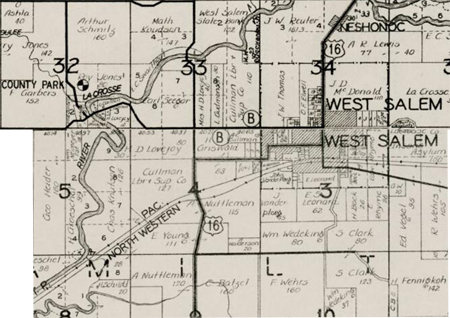
In the upper left is shown the original Waterloo Park location,
from the Atlas of La Crosse County, Wisconsin, 1931
When Highway 16 was completed in 1936, the La Crosse County Board Park Committee relocated Waterloo Park to where it is now, south of Highway 16 on the eastern bank of the La Crosse River. The former Waterloo Park also was the home of a Civilian Conservation Corps (CCC) camp in the 1930s. Later, some old CCC barracks were repurposed as shelter houses in the relocated Waterloo Park and Onalaska Park. These CCC barracks/shelters were replaced by the 1980/1990s.
At the site of the new Waterloo Park, the County Park Commission altered the course of the La Crosse River in hopes of creating a lagoon. In the 1930s, the Works Progress Administration (WPA), a federal program designed to infuse federal funds into local economies, made improvements in Waterloo Park.
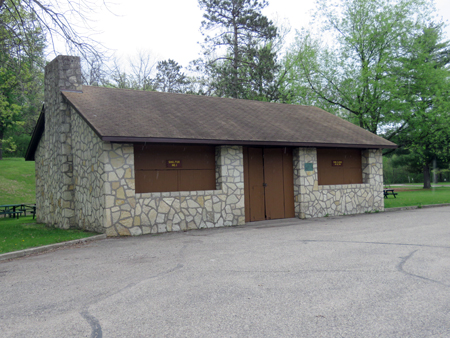
Shelter #1 was completed in 1937 with federal funds
from the Works Progress Administration; photographed by Anita Doering, 2019
The WPA funded shelter house was erected in 1937 and was identical to the one installed at the Onalaska Park. Built of local limestone, Shelter #1 measures 28 feet wide and 42 feet long. The rock walls are 18 inches thick. Originally, two sides of the building were closed while the other two were left open. The building foundation is five-inch thick reinforced concrete, and the heavy dark oak timbers were originally covered with asphalt shingles. Other amenities in the park at this time (1937) were picnic tables, benches, playground equipment and a ball diamond and well water. In 1939 another 11 acres was added to the park.
In the 1940s, the stagnant water in the park where the old La Crosse River channel had been was bothersome. Plans were made to fill in the area, but instead the park committee ordered a new well to be drilled to the left of the road entering the park near the slough. Henry Wick, well driller, set to work and drilled 100 feet just to find rock. But from his experience he knew an artesian well could be found.
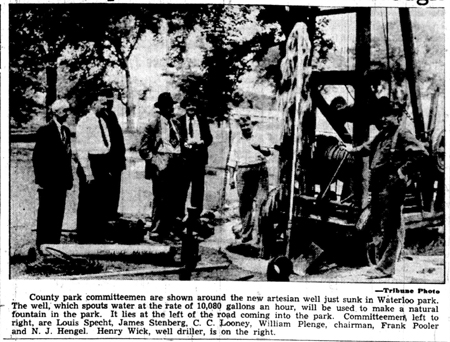
La Crosse Tribune, June 8, 1941, page 5
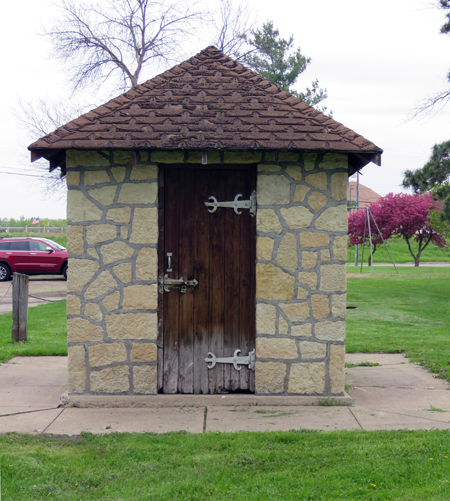
Artisan well photographed by Anita Doering, 2019
Committee members authorized the deeper digging and 390 feet later the five-inch pipe was happily producing 10,080 of artesian well water an hour. In this way, a fountain could be built, giving the slough a constant turn of water. Eventually the slough turned into a lagoon.

Fountain, photographed by Anita Doering, 2019
A stone bridge was completed in 1942 with WPA funds and two large culverts handled flood water. About 70 feet long and wide enough for two cars to pass, it quickly became a favorite fishing spot for sunfish and crappies. The half-mile road project was built with the aid of WPA funds. Other WPA projects beyond the stone bridge and shelter house were a retaining wall, artisan well, fountain and stone pathways.
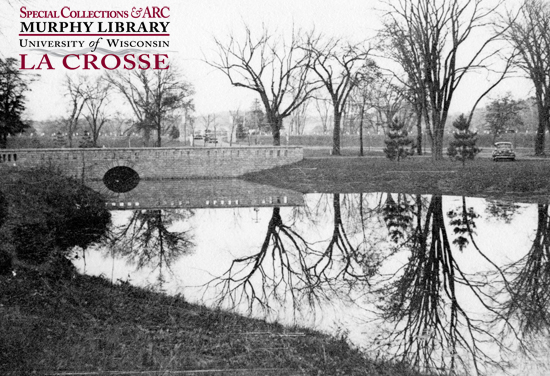
Stone lagoon bridge courtesy of the UWL, Murphy Library,
Special Collections Department
Other concepts in the five-year plan included dredging out the old mud bottom of the lagoon and replacing it with sand for wading. The La Crosse River was again rerouted with a large dike and fortified with piling. The dike prevented the river from backing up into the pool but lets the pool overflow into the river. Two look-out points were constructed on the hilly portions of the park for a general view of the lagoon, bridge and fountain.
Waterloo Park was renamed Veteran’s Memorial Park in February 1945 to be “dedicated to the men and women of La Crosse County who served in the armed forces of World War I and World War II.” The Stanley Christianson Memorial was added in 1959 to recognize local war veterans. From the Mindoro area, Christianson lost his life in the Korean War in 1950 and was posthumously awarded the Congressional Medal of Honor.
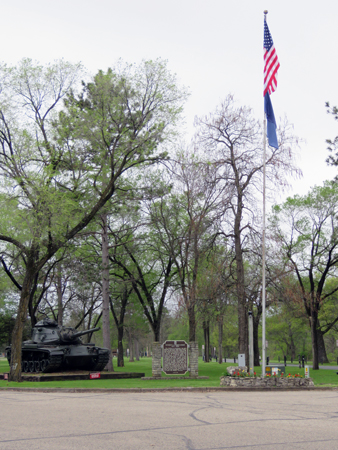
Christianson Memorial, photographed by Anita Doering, 2019
Eventually, more shelter houses were added, as well as sports fields and courts, and the camping grounds. Many trees were planted. Giant elms were lost to disease and were replaced by deciduous trees in the 1980s. The trout that live in the pond were added in the 1970s/1980s. Because the main source of water is ground water (springs) from neighboring wetland pasture and a small artesian well, it has proven difficult to maintain healthy water quality in the pond. In 2015, a partnership between La Crosse County and the West Salem Rod and Gun Club, County Conservation Aids, The Friends of Lake Neshonoc and the Wisconsin DNR resulted in pond improvements with an aeration system.
Additional land for the park was acquired in the mid 1990s. The County purchased approximately 97 acres from LaVerne Nuttleman for purposes of a bike trail extension. An easement was received from the Soo Line Railroad Co., and the bike trail was extended from the park to the La Crosse River State Bike Trail using a cost share grant from the Intermodal Surface Transportation Efficiency Act (ISTEA) Enhancement Program for $118,000). In 1997, Don Brenengen donated 22 acres of land.

Bike trail extension photographed by Anita Doering, 2019
Veterans’ Memorial Park continues to be a busy park with fishing, sports and recreational activities, gathering spaces and a campground. La Crosse County has spent many years beautifying and improving the park to be welcoming and beneficial to all. It contains many of its original WPA natural stone structures, adding to the beauty and historical significance of the park.

